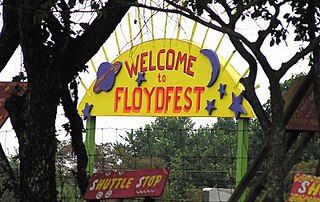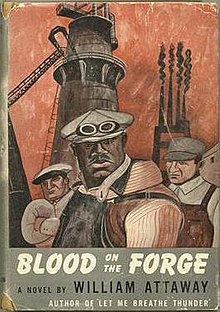Chicago blues is a form of blues music that developed in Chicago, Illinois. It is based on earlier blues idioms, such as Delta blues, but is performed in an urban style. It developed alongside the Great Migration of African Americans of the first half of the twentieth century. Key features that distinguish Chicago blues from the earlier traditions, such as Delta blues, is the prominent use of electrified instruments, especially the electric guitar, and especially the use of electronic effects such as distortion and overdrive.

United States Steel Corporation, more commonly known as U.S. Steel, is an American integrated steel producer headquartered in Pittsburgh, Pennsylvania, with production operations primarily in the United States of America and in Central Europe. The company produces and sells steel products, including flat-rolled and tubular products for customers in industries across automotive, construction, consumer, electrical, industrial equipment, distribution, and energy. Operations also include iron ore and coke production facilities.

The Great Migration, sometimes known as the Great Northward Migration or the Black Migration, was the movement of 6 million African Americans out of the rural Southern United States to the urban Northeast, Midwest, and West between 1910 and 1970. It was caused primarily by the poor economic conditions for African American people, as well as the prevalent racial segregation and discrimination in the Southern states where Jim Crow laws were upheld. In particular, continued lynchings motivated a portion of the migrants, as African Americans searched for social reprieve. The historic change brought by the migration was amplified because the migrants, for the most part, moved to the then-largest cities in the United States at a time when those cities had a central cultural, social, political, and economic influence over the United States. There, African Americans established influential communities of their own. Despite the loss of leaving their homes in the South, and the barriers faced by the migrants in their new homes, the migration was an act of individual and collective agency, which changed the course of American history, a "declaration of independence" written by their actions.
A work song is a piece of music closely connected to a form of work, either sung while conducting a task or a song linked to a task that might be a connected narrative, description, or protest song. An example is "I've Been Working on the Railroad".

William Z. Foster was a radical American labor organizer and Communist politician, whose career included serving as General Secretary of the Communist Party USA from 1945 to 1957. He was previously a member of the Socialist Party of America and the Industrial Workers of the World, leading the drive to organize the packinghouse industry during World War I and the steel strike of 1919.

A cotton mill is a building that houses spinning or weaving machinery for the production of yarn or cloth from cotton, an important product during the Industrial Revolution in the development of the factory system.

Textile manufacture during the British Industrial Revolution was centred in south Lancashire and the towns on both sides of the Pennines in the United Kingdom. The main drivers of the Industrial Revolution were textile manufacturing, iron founding, steam power, oil drilling, the discovery of electricity and its many industrial applications, the telegraph and many others. Railroads, steamboats, the telegraph and other innovations massively increased worker productivity and raised standards of living by greatly reducing time spent during travel, transportation and communications.

Joseph James "Smiling Joe" Ettor (1885–1948) was an Italian-American trade union organizer who, in the middle-1910s, was one of the leading public faces of the Industrial Workers of the World. Ettor is best remembered as a defendant in a controversial trial related to a killing in the seminal Lawrence Textile Strike of 1912, in which he was acquitted of charges of having been an accessory.
"Tzena, Tzena, Tzena", sometimes "Tzena, Tzena", is a song, written in 1941 in Hebrew. Its music is by Issachar Miron, a Polish emigrant in what was then the British Mandate of Palestine, and the lyrics are by Yechiel Chagiz.

FloydFest is a Music and arts festival held annually near Floyd, Virginia, in the Blue Ridge Mountains
Gerdau is the largest producer of long steel in the Americas, with steel mills in Brazil, Argentina, Canada, Colombia, Dominican Republic, Mexico, Peru, United States, Uruguay and Venezuela. Currently, Gerdau has an installed capacity of 26 million metric tons of steel per year and offers steel for the civil construction, automobile, industrial, agricultural and various sectors.

William Alexander Attaway was an African-American novelist, short story writer, essayist, songwriter, playwright, and screenwriter.

Pittsburgh is a 1942 American drama film directed by Lewis Seiler and starring Marlene Dietrich, Randolph Scott, and John Wayne. Based on a story by George Owen and Tom Reed, the film is about an ambitious coal miner who values wealth and power in the Pittsburgh steel industry over his friends, lovers, and ideals, only to find himself deserted and alone at the top. When his fortune crumbles around him, he discovers that fate offers him an unexpected second chance. Filmed partially on location in Pittsburgh, Pennsylvania, the film co-stars Shemp Howard of Three Stooges fame in a rare dramatic role. Dietrich, Scott, and Wayne also made The Spoilers together that same year. Scott received top billing over Wayne in both films despite the fact that Wayne's roles were larger and more important.
The social novel, also known as the social problemnovel, is a "work of fiction in which a prevailing social problem, such as gender, race, or class prejudice, is dramatized through its effect on the characters of a novel". More specific examples of social problems that are addressed in such works include poverty, conditions in factories and mines, the plight of child labor, violence against women, rising criminality, and epidemics because of over-crowding and poor sanitation in cities.

James Johnson Edwards was an American actor in films and television. His most famous role was as Private Peter Moss in the 1949 film Home of the Brave, in which he portrayed a Black soldier experiencing racial prejudice while serving in the South Pacific during World War II.

Barrow Bridge is a model village in the north-west outskirts of Bolton in Greater Manchester, England. It was created in the Industrial Revolution but since the demolition of the mills is now a residential village.
Ruth Attaway was an American film and stage actress. Among the films she appeared in are Raintree County (1957), Porgy and Bess (1959) and Being There (1979).

The National Museum of Industrial History, abbreviated NMIH, housed in the former facility of Bethlehem Steel in Bethlehem, Pennsylvania, is a museum affiliated with the Smithsonian Institution that seeks to preserve, educate, and display the industrial history of the nation. It holds a collection of artifacts from the textile, steel and iron, and propane gas industries. The NMIH holds a significant collection of industrial machinery on loan from the institute's National Museum of American History. The museum also has a large collection of documents, machinery, photographs, and other archival material from Bethlehem Steel, one of the world's largest steel manufacturers prior to its 2001 bankruptcy and 2003 dissolution.

The Dollmaker is a novel by Harriette Arnow. It is the story of Gertie Nevels and her family's migration from their Kentucky homeland to industrial Detroit during World War II. First published in 1954, the novel earned a 1955 nomination for the National Book Award. Its New York Times book reviewer called it a superb novel, notable for its strength and the glowing richness of character and scene. In 1971, Joyce Carol Oates characterized this novel as "our most unpretentious American masterpiece".
The Metro Detroit region of Michigan is home to a significant Appalachian population, one of the largest populations of Urban Appalachians in the United States. The most common state of origin for Appalachian people in Detroit is Kentucky, while many others came from Tennessee, West Virginia, Virginia, Ohio, and elsewhere in the Appalachia region. The Appalachian population has historically been centered in the Detroit neighborhoods of Brightmoor, Springwells, Corktown and North Corktown, as well as the Detroit suburbs of Hazel Park, Ypsilanti, Taylor, and Warren. Beginning after World War I, Appalachian people moved to Detroit in large numbers seeking jobs. Between 1940 and 1970, approximately 3.2 million Appalachian and Southern migrants settled in the Midwest, particularly in large cities such as Detroit and Chicago. This massive influx of rural Appalachian people into Northern and Midwestern cities has been called the "Hillbilly Highway". The culture of Metro Detroit has been significantly influenced by the culture, music, and politics of Appalachia. The majority of people of Appalachian heritage in Metro Detroit are Christian and either white or black, though Appalachian people can be of any race, ethnicity, or religion.













